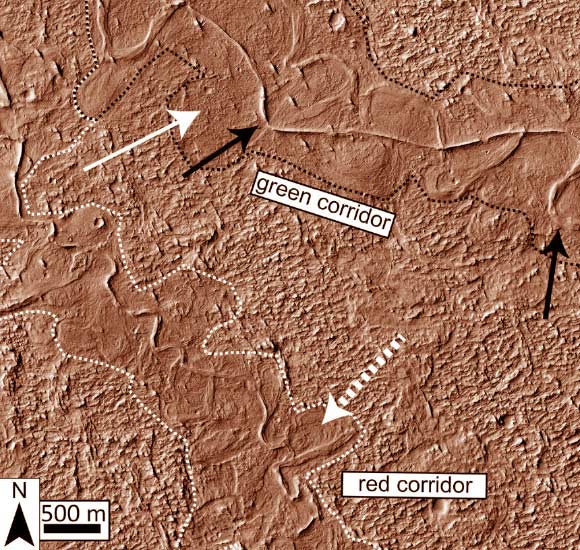River deposits exist across the Martian surface. A large sedimentary basin named Aeolis Dorsa contains some of the planet’s most spectacular and densely packed river deposits. In a new paper published in the Geological Society of America Bulletin, planetary researchers provide evidence that these deposits represent incised valleys carved and filled during falls and rises in base level, which were likely controlled by changes in water-surface elevation of a large lake or sea.

Aeolis Dorsa, Mars: the dotted white arrow points to curved strata recording point bar growth and river migration; the boundaries of ancient valley walls are defined by textural and albedo changes and are also associated with lateral river migration; stacked above the point bars and completely confined within the dotted white and black lines are topographically inverted river deposits outcropping as ridges (e.g., black arrow); in places (e.g., south of the dotted white arrow), the ridges run against the dotted boundaries, suggesting flow was once redirected along a valley wall. Image credit: Cardenas et al, doi: 10.1130/B31567.1.
“Some of the best exposures of sedimentary deposits on Mars are located in the Medusae Fossae Formation at Aeolis Dorsa,” said lead author Benjamin Cardenas and colleagues from the Jackson School of Geosciences at the University of Texas at Austin.
“Deposition occurred during the Hesperian (3.7 to 3 billion years ago), with current surfaces exposed via erosion during the Hesperian through the early Amazonian (2.5 billion years ago).”
These deposits are observable with satellite images because they have undergone a process called ‘topographic inversion,’ where the deposits filling once topographically low river channels have been exhumed in such a way that they now exist as ridges at the Martian surface.
“These ridges have been hypothesized to represent eskers, inverted lava flows, and inverted river-channel-filling deposits. However, their arrangement into sinuous ridge networks and the occurrence of internal stratigraphy that appears to record the lateral migration of channels support an interpretation that a vast majority of these are river-channel deposits,” the researchers said.
Using high-resolution images from the Context Camera (CTX) and High Resolution Imaging Science Experiment (HiRISE) instruments onboard NASA’s Mars Reconnaissance Orbiter and topographic data from the Mars Orbiting Laser Altimeter (MOLA) onboard NASA’s Mars Global Surveyor, they identified river deposit stacking patterns and changes in sedimentation styles controlled by a migratory coastline.
They also developed a method to measure river paleo-transport direction for a subset of these ridges.
Together, these measurements demonstrate that the studied river deposits once filled incised valleys.
“On Earth, incised valleys are commonly cut and filled during falling and rising eustatic sea level, respectively,” the scientists said.
“Similar falling and rising water levels in a large water body forced the formation of the paleo-valleys in the study area.”
Cross-cutting relationships are observed at the valley-scale, indicating multiple episodes of water level fall and rise, each well over 50 m, a similar scale to eustatic sea level changes on Earth.
The conclusion that such large water level fluctuations and coastline movements were recorded by these river deposits suggests some long-term stability in the controlling, downstream water body, which would not be expected from catastrophic hydrologic events.
_____
Benjamin T. Cardenas et al. Fluvial stratigraphy of valley fills at Aeolis Dorsa, Mars: Evidence for base-level fluctuations controlled by a downstream water body. GSA Bulletin, published online September 2017; doi: 10.1130/B31567.1







